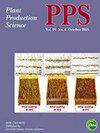A novel index to evaluate resource allocation pattern in panicles in Japanese rice cultivars
IF 1.3
3区 农林科学
Q2 AGRONOMY
引用次数: 0
Abstract
ABSTRACT The major impact of both genotypic and environmental factors on grain-filling efficiency of rice (Oryza sativa L.) makes evaluating cultivar’s grain-filling characteristics highly complicated. To assess grain-filling characteristics, the allocation index (Alli) was defined as a novel indicator representing the pattern of resource allocation in panicles. Alli was calculated as the ratio of source of yield utilized for producing well-filled grains to the total source consumed in a panicle, using estimated grain weight distribution data. We measured the Alli of 91 Japanese rice cultivars grown under nine environments involving multiple years, cropping seasons, three sites, and flag leaf clipping. Each cultivar’s stability in Alli was evaluated using the data of various sink–source balance conditions. As a result of integrated analysis of multiple cultivars, we observed a trade-off relationship between the stability of Alli and the stability of mean weight of well-filled grains (mu2). The popular high-yielding cultivars Hokuriku 193 and Takanari showed high stability of Alli and mu2 under various sink–source balance conditions. Among the 91 cultivars, Hokuriku 193 showed stable characteristics with a high sink-filling ratio. Our results demonstrate that the grain weight distribution and Alli could be used as novel indicator of grain-filling characteristics, and that the trade-off relationship between the stability of Alli and mu2 should be considered when we select cultivars for multi-environmental cultivation.一种评价日本水稻品种穗部资源分配格局的新指标
基因型和环境因素对水稻籽粒灌浆效率的主要影响使评价品种灌浆特性变得非常复杂。为了评估籽粒灌浆特性,分配指数(Alli)被定义为一种新的指标,代表了穗中资源分配的模式。根据估计的粒重分布数据,将Alli计算为用于生产饱满谷物的产量来源与穗部消耗的总产量来源的比率。我们测量了91个日本水稻品种在九种环境下生长的Alli,包括多年、种植季节、三个地点和旗叶修剪。利用不同库源平衡条件下的数据评估了每个品种在Alli中的稳定性。作为对多个品种的综合分析的结果,我们观察到Alli的稳定性与饱满谷物平均重量(mu2)的稳定性之间存在权衡关系。在各种库源平衡条件下,广受欢迎的高产品种Hokuriku193和Takanari表现出较高的Alli和mu2稳定性。在91个品种中,北陆193表现出稳定的特性,具有较高的库填充率。结果表明,粒重分布和Alli可以作为衡量籽粒灌浆特性的新指标,在选择多环境栽培品种时,应考虑Alli和mu2的稳定性之间的权衡关系。
本文章由计算机程序翻译,如有差异,请以英文原文为准。
求助全文
约1分钟内获得全文
求助全文
来源期刊

Plant Production Science
农林科学-农艺学
CiteScore
5.10
自引率
4.00%
发文量
27
审稿时长
>36 weeks
期刊介绍:
Plant Production Science publishes original research reports on field crops and resource plants, their production and related subjects, covering a wide range of sciences; physiology, biotechnology, morphology, ecology, cropping system, production technology and post harvest management. Studies on plant production with special attention to resource management and the environment are also welcome. Field surveys on cropping or farming system are also accepted. Articles with a background in other research areas such as soil science, meteorology, biometry, product process and plant protection will be accepted as long as they are significantly related to plant production.
 求助内容:
求助内容: 应助结果提醒方式:
应助结果提醒方式:


